Article and all photos by Joe Mock, BaseballParks.com
All rights reserved
 |
The Winston-Salem Warthogs had a great plan in place. In 2008, they would play their final season at aging Ernie Shore Field, with all the pomp and celebrations that come with saying goodbye to a city’s pro-baseball home for over half a century. They would then hand off the ballpark to Wake Forest University, and launch a new round of celebrations as they moved into the new, state-of-the-art ballpark across town in 2009 — a park that was going to anchor a $189-million commercial development in a blighted area on the western edge of downtown. They even implemented a completely new identity for the team, with a sporty new logo and team nickname.
| Ballpark Stats |
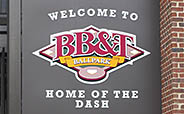 |
| Team: Winston-Salem Dash of the Class A Carolina League |
| First game: April 13, 2010, a 5-4 loss to Potomac |
| Capacity: 6,200, of which 5,500 are theater-style seats |
| Architect: 360 Architecture and CJMW |
| Construction: Samet |
| Price: $48.7 million |
| Home dugout: First base side |
| Field points: North by northeast |
| Playing surface: Bermuda grass overseeded with rye |
| Betcha didn’t know: Even though the masonry doesn’t extend all the way around the park’s perimeter, there were still 26,000 bricks used in the construction |
There was only one problem: they couldn’t move into the new park because it wasn’t completed by its scheduled opening day, April 23, 2009. That’s OK, the team said, because we’ll play for just a few weeks at the old park, and then move into the new digs sometime in May. Then it was going to be by mid-season. Then not at all in 2009.
This frustrated me because I made several trips to visit the stadium, including one in July of 2009 so I could photograph and review the completed park. No dice. My frustration was nothing compared to the locals, though. As stories crept into the newspapers early in 2009 that there were disagreements among the team’s owners and that the contractors building the facility had stopped receiving checks, Winston-Salem’s baseball fans grumbled when it was announced that their new showplace wasn’t going to be completed on time. When the city government felt that it had to step in with $12.7 million to ensure the completion of the construction — pushing the total price to get the park completed (according to several publications) to over $48 million — local residents positively howled with outrage, especially since so many of them drove right past the almost-completed structure on a major thoroughfare every day. And the area pegged for redevelopment still had the same abandoned, boarded up houses right across the street from the unfinished stadium.
Locals demonstrated their outrage with countless letters to local media outlets, usually with the refrain “I don’t care how nice the completed park is, I will never attend a game there!” They also showed their displeasure by refusing to attend games of the Dash (the team’s new name in 2009) back at Ernie Shore, as attendance plummeted from 170,053 in 2008 to a miniscule 57,655 in 2009, the lowest full-season total in the Carolina League since 1986.
Ownership of the Dash stayed the course, though. They hired a new team president in Geoff Lassiter, a popular local choice since he’d spent the previous eight years in the Athletic Department at Wake Forest. And they crossed their fingers that the ire of the fan base would subside once they saw how nice the finished park is.
It worked.
| Off to college |
 |
| Ernie Shore Field has been Winston-Salem’s baseball home since 1956. With the Dash now playing downtown, it won’t meet the wrecking ball, though. The facility was sold to Wake Forest University, and it is now the home of Demon Deacon baseball. |
BB&T Ballpark, with its gorgeous exterior, beautiful view of the city’s skyline and all of the fan amenities anyone could want, made its much-delayed debut on April 13, 2010. I guess it was impossible for local fans not to fall in love with the place, as attendance has soared. It is on a pace to double the franchise’s previous attendance record. Obviously, fans found the ballpark worth the wait … and so did we.
Lassiter admits that there were definitely some tough moments in 2009, though. “The overall perception of the adversity (in 2009) is hard to capture unless you were right here in the middle of it,” he told me. “Any time public dollars end up being involved, there will be people on both sides of the issue. Once it was completed, though, people saw the value (in the park). We found that when you walk through the ballpark’s gates, any reservations you might have had go away because of the ‘wow factor’ of the park.”
Indeed. I am a living example of what Lassiter is talking about. After all of the turmoil of last year, I had a preconceived notion that I wouldn’t like it. The negative feelings vanished as I visited the completed facility. Truly, I was quickly convinced that this park deserves to be the 2010 BASEBALLPARKS.COM Ballpark of the Year (see our press release to the media here)!
As we will see, the $189 million development around the park isn’t a reality yet. The dilapidated houses are still there across the street, but I now feel like the revitalization of the neighborhood will definitely occur. It all starts with the ballpark, though, and that’s what this review is about. We’ll indeed look at the new stadium’s surroundings, its stunning masonry exterior, its interior design and what it’s like to attend a Dash game. In the end, I think you’ll agree that this special facility was worth waiting for.
The Setting
BB&T Park isn’t near Ernie Shore Field at all. For decades, fans were used to driving well north of Winston-Salem’s downtown to attend pro-baseball games, as Ernie Shore Field sits where Wake Forest’s athletic facilities are located. Ironically, the old park is directly next door to BB&T Field, the Demon Deacon’s huge football stadium. Keep this in mind if you plug “BB&T Ballpark” into a GPS, because it may well lead to you to the “BB&T Field” football stadium instead.
BB&T Ballpark is located on the southwestern edge of downtown. Its proximity to a major highway (called by several names, including Interstate 40 Business Loop and US 421) not only makes it easy to get to, it gives it great visibility to an enormous number of commuters each day. However, I’ve seen misleading directions to the park on several websites that tell you take I-40 directly to the park. Technically, that’s not correct. The “real” I-40 runs parallel to “Business 40” a few miles to the south. If you stay on I-40 all the way through the Winston-Salem metro area, you’ll never see the ballpark. You need to look for Business 40.
The facility is nestled between two exits of Business 40, the Peters Creek Parkway exit and the one for Broad Street. Interestingly, Peters Creek is on the west side of the park, but it’s the exit you would take if you are heading west on Business 40. Broad Street is east of the ballpark, but it’s the one you would take if you’re heading east on Business 40. In both instances, you’ll clearly see the beautiful stadium on the north side of the travel lanes when it’s time to exit.
But the accessibility of the park is only a part of the story of its location. As mentioned previously, the ballpark is the anchor for a $189-million development that will encompass 33 acres. As of this writing, the only aspect of this development that has been completed (or even begun) is the stadium and its parking lots. It makes sense that BB&T Ballpark represents the first phase of the project. As Lassiter put it, “Since 80,000 cars go by a day on the highway, we designed the park to be the ‘front door’ of downtown.” A great objective.
 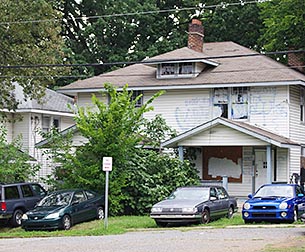 |
There’s also an unfortunate aspect of this, though. Directly across Peters Creek Parkway from the stadium’s left field (above left) are the boarded-up, dilapidated houses (above right). These are an eyesore, and detract from the ballpark’s setting. Happily, Lassiter assured me that those houses are part of the 33 acres that will be developed, so they should be gone soon enough.
The stadium’s parking lots (below) are all beyond the outfield, up a hill from the main gates and ticket windows, which are at the base of the scoreboard in right-center field. As you might guess, parking for season-ticket holders is closest to the gates, and “paid parking” is a little farther up the hill. For weekend games with big crowds, there probably aren’t enough spaces in these close-by lots. Thankfully, there is a free shuttle that runs by various parking lots downtown, including the large City Center West parking garage. The Dash partners with the Winston Salem Downtown Partnership to operate this shuttle for all Thursday, Friday and Saturday evening home games.
 |
Speaking of downtown, the ballpark’s location and orientation permit most fans to have a nice view of Winston-Salem’s skyline. No, it’s not like looking across the river at Pittsburgh’s downtown “triangle” from within PNC Park, but it’s a pleasant view nonetheless. And what is one of the prominent buildings that you see as you look east toward the skyline? Why, the BB&T Financial Center, of course! That’s the bank that paid for the naming rights on the park for the next 15 years.
The Exterior
From the moment you first spot BB&T Ballpark from Business 40, it is abundantly clear that an enormous amount of effort was put into the outside of this facility. Of all of 2010’s new or rebuilt parks, I think this one has the most handsome exterior.
While stone can certainly make for a beautiful exterior wall (like at PNC Park), I’m a sucker for brick as the most classic look for a baseball facility. CJMW, a local firm that was the Architect of Record on the project, teamed up with nationally known 360 Architecture to design BB&T Ballpark. They felt strongly (as did the ownership of the Dash) that brick should be used, and did they ever use a lot of them — 26,000 to be exact. In fact, the Dash like to point out that if you lined up these bricks end-to-end, it would stretch for 26 miles … which is exactly the distance from Winston-Salem’s new park to Greensboro’s NewBridge Bank Ballpark (called First Horizon Park when we reviewed it in its first season), as the crow flies.
The exterior perimeter of the outfields has attractive wrought-iron fencing, which allows a very welcomed openness, as you can see by the photo in the Setting section above. However, this is nothing compared to the intricate masonry around the infield and out toward right field. And I’m sure the design of this was made more challenging by the fact that the park is built into a hillside.
 |
There are two entryways on this “masonry” side of the park, and it’s a shame that neither is used very heavily. The entry in the left-hand shot below (with one of the quaint gas-lamp-looking lights that illuminate the walkways around the grounds) is just to the third-base side of home plate. Unless someone drives you to the park and drops you off, you’re not likely to utilize this gate because there isn’t any parking nearby. On the right side below is the “Womble Carlyle Club Entrance” that leads you to elevators to take you up two floors to the lounge. This beautiful entry is next to a small lot on the Business 40 side of the park.
 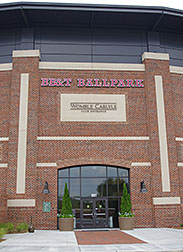 |
Just to the right of this Club entry is a series of distinctive wooden doors (below left). They mirror the shape of the nearby entryway, but if you look closely, you’ll notice that the doors are only decorative. If you examine the mulch and landscaping in the photo, you’ll discover that the doors don’t actually open. They are simply there for the aesthetics, as they resemble old-style carriage doors — perfect to complement the rest of the vintage exterior. Very nice touch.
Nearby is a structure that drivers on Business 40 can’t miss. This storage building bearing a huge ballpark logo (below right) is next to a high-resolution sign that can promote upcoming games.
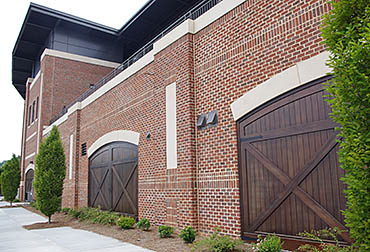 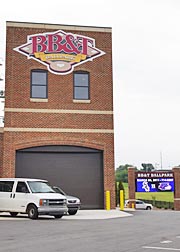 |
Around on the outfield side are two entries. The smaller one is in left field, right at the base of a grassy hillside. It rained prior to the game I attended, so that hill was pretty slippery. As I watched from inside the park, I saw more than one fan slip and fall while trying to descend the slope from up on Peters Creek Parkway (below left). Lassiter told me that while stairs are not planned for this spot, once the commercial buildings are constructed nearby, there will be better, safer ways for fans to reach that gate from the street.
The main entrance area for the entire facility is the one near center field (below center). There is a pleasant plaza there in front of the Dash’s ticket windows. The look of this area should be quite different in 2011, though, as a five-story commercial building will be built just to the left of the entryway (the spot is already graded — see below right). The building was designed by CJMW, who, you’ll recall, collaborated on many elements of the ballpark’s design with 360 Architecture. The structure will be the permanent home of the team’s merchandise shop, and will likely house offices and a restaurant that will be open year-round. “Construction will start after the season is over,” Lassiter told me. “There are quite a few tenants on board, because the banks (financing the construction) wouldn’t let us move forward without the majority of the building being leased.”
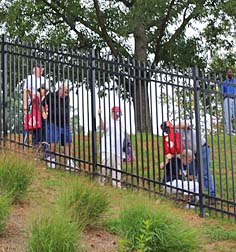 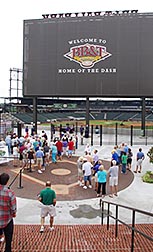 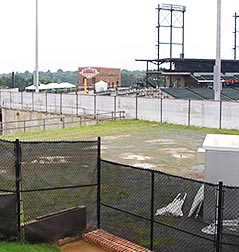 |
So while the surroundings of the park are still evolving, the exterior (with the exception of the commercial building) is set — and that’s a good thing because it is quite lovely. In this respect, BB&T Ballpark is similar to Huntington Park in Columbus, which 360 also designed. So similar, in fact, that fans entering both ballparks might not notice the exquisite brickwork around both facilities’ infields because the main entryways are in the outfield.
Let’s now venture inside now to see what things are like within the ballpark.